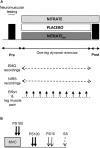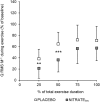Dietary Nitrate Supplementation Improves Exercise Tolerance by Reducing Muscle Fatigue and Perceptual Responses
- PMID: 31068827
- PMCID: PMC6491676
- DOI: 10.3389/fphys.2019.00404
Dietary Nitrate Supplementation Improves Exercise Tolerance by Reducing Muscle Fatigue and Perceptual Responses
Abstract
The present study was designed to provide further insight into the mechanistic basis for the improved exercise tolerance following dietary nitrate supplementation. In a randomized, double-blind, crossover design, twelve recreationally active males completed a dynamic time-to-exhaustion test of the knee extensors after 5 days of consuming both nitrate-rich (NITRATE) and nitrate-depleted beetroot juice (PLACEBO). Participants who improved their time-to-exhaustion following NITRATE performed a time-matched trial corresponding to the PLACEBO exercise duration with another 5 days of dietary nitrate supplementation. This procedure was performed to obtain time-matched exercise trials with (NITRATEtm) and without dietary nitrate supplementation (PLACEBO). Neuromuscular tests were performed before and after each time-matched condition. Muscle fatigue was quantified as percentage change in maximal voluntary torque from pre- to post-exercise (ΔMVT). Changes in voluntary activation (ΔVA) and quadriceps twitch torque (ΔPS100) were used to quantify central and peripheral factors of muscle fatigue, respectively. Muscle oxygen saturation, quadriceps muscle activity as well as perceptual data (i.e., perception of effort and leg muscle pain) were recorded during exercise. Time-to-exhaustion was improved with NITRATE (12:41 ± 07:18 min) compared to PLACEBO (09:03 ± 04:18 min; P = 0.010). NITRATEtm resulted in both lower ΔMVT and ΔPS100 compared to PLACEBO (P = 0.002; P = 0.001, respectively). ΔVA was not different between conditions (P = 0.308). NITRATEtm resulted in reduced perception of effort and leg muscle pain. Our findings extend the mechanistic basis for the improved exercise tolerance by showing that dietary nitrate supplementation (i) attenuated the development of muscle fatigue by reducing the exercise-induced impairments in contractile muscle function; and (ii) lowered the perception of both effort and leg muscle pain during exercise.
Keywords: beetroot juice; central fatigue; contractile function; muscle pain; performance fatigability; peripheral fatigue.
Figures




References
LinkOut - more resources
Full Text Sources

